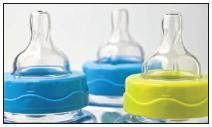Rockville, MD—Following some 30 years of toxicology research surrounding the health threats of bisphenol-A (BPA) exposure, the U.S. Food and Drug Administration (FDA) is finally stating that there exists “some concern” for infants and children exposed to this chemical after having stated it was harmless fo r decades. Since the 1930s, BPA used in the synthesis of many polycarbonate plastics has been incorporated in baby and water bottles, sports equipment and many other common items.
r decades. Since the 1930s, BPA used in the synthesis of many polycarbonate plastics has been incorporated in baby and water bottles, sports equipment and many other common items.
A surfeit of BPA data, research and reports has demonstrated the detrimental pharmacokinetic effects of this endocrine disruptor on the body. The most conclusive research was conducted in the past five years due to innovations in BPA research. In 2008, the U.S. National Toxicology Program reported “some concern for effects on the brain, behavior, and prostate gland in fetuses, infants and children at current human exposures to [BPA].” At an average exposure rate of 13 µg/kg/day, infants are at the greatest risk, as baby food containers and bottles are often made with BPA. A 2008 study by the Yale School of Medicine demonstrated a connection between BPA and interference with brain cell connections vital to memory, learning and mood when administered at the maximum dose deemed safe by the Environmental Protection Agency (50 µg/kg/day) to non-human primates.
Several studies have also been published defining BPA as a possible carcinogen. In a 2006 mouse study, the genesis of adult-onset precancerous lesions of the prostate as well as hormonal carcinogenesis were observed after BPA exposure at 10 µg/kg/day. Additionally, in vitro studies have shown that BPA induces neoplastic transformation in breast epithelial cells (2009), the proliferation of neuroblastoma cells (2010) and increased prostate size (2007). A 2008 study published in JAMA showed a correlation between BPA levels in urine and increased risk of heart disease in men and women.
The list of scientific publications against the exposure to BPA goes on; however, due to the abundance of BPA in our everyday lives, the reduction of exposure to this harmful compound is not so easy without proper federal regulation. FDA took a progressive step in its statement on January 15, 2010 validating the concern for BPA exposure. During this provisional time of BPA policy change, FDA is supporting the food industry’s actions to stop producing BPA-containing feeding containers and facilitating BPA-alternative development and the reduction of BPA in can and food linings.
While these initial actions being taken in light of FDA’s new stance against BPA are important, anti-BPA advocates feel they are not enough. These groups believe new regulation, rather than simple support for R&D, is what’s necessary; however, FDA currently has no such authority. According to Frederick vom Saal, Ph.D., of the University of Missouri, who has studied the adverse effects of BPA on physiological function since 1997, “The Japanese industry voluntarily removed BPA from can linings 10 years ago and thus, was able to reduce exposure to BPA by 50 percent. Last year, Congress asked companies in the United States to take similar actions; however, companies have made no such effort toward compliance. A huge problem facing the FDA is that it does not have the regulatory authority to even determine what products contain BPA, and Congress will have to pass new laws giving the FDA the authority it needs to regulate chemicals such as BPA.”










